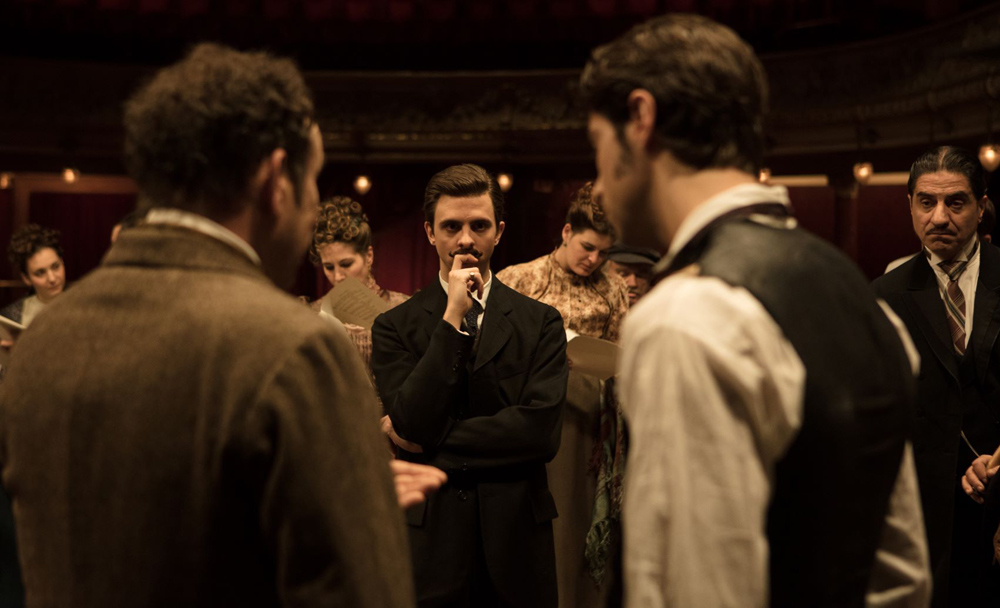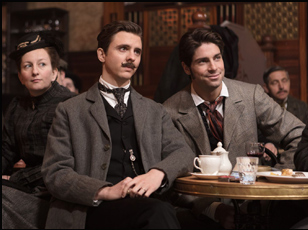When adapting his play “Edmond and Cyrano” into a film after it had become a sensation on the French stage, fancifully reworking the origin story of Edmond Rostand’s “Cyrano de Bergerac,” Alexis Michalik knew he would have to devote much of his energy behind the camera to what would be his feature directorial debut “Cyrano, My Love,” so it was unlikely that the multi-hyphenate would have much time to act in it. Still, he couldn’t help but save a small part for himself so he wouldn’t completely miss out on the fun and his choice is telling.
“I wasn’t sure whether I was going to play Chekhov or Feydeau, but it was of course funny with me being a playwright that I would play a playwright,” recalls Michalik, having his choice of famed writers who make Rostand feel inferior in the lead up to his first major hit. “And it was also funny to play this toast of the town, but also kind of a pompous ass that is Georges Feydeau. He wasn’t like this at all in real life, but I love to play bad guys in movies. I find it so much funnier.”
It was only fair that Michalik would play Rostand’s professional nemesis, whose success far outstripped his pre-“Cyrano,” after Rostand has bedeviled Michalik for so long — inspiring him so much that it made no sense when the writer/director couldn’t find film financing for what he was sure was a smash comedy, but while he created his own opportunity by taking “Cyrano” to the stage first, it imagines Rostand waiting for lightning to strike, following the poet attempting to translate his work into a respectable career in the theater with little success, even with the great Sarah Bernhardt performing his plays. With his name associated to failure, he struggles to get anything off the ground, but being anonymous comes with its benefits as he finds when his actor friend Leo (Tom Leeb) starts to lean on him for romantic help as he tries to woo Jeanne (Lucie Boujenah), a costume designer on a production he’s working on, making use of his way with words.
As Leo and Jeanne fall in love and Rostand finds a passion for his craft once more, Michalik makes it difficult to resist the charms of “Cyrano, My Love,” not only in how he’s able to toy with what audiences may know already of the playwright and his legendary work, but in his sweeping style with camerawork that pirouettes around the stage and the streets of Paris as if under the spell of inspiration. “Cyrano, My Love” is able to build upon one crowdpleaser to become one on its own and during a recent visit to Los Angeles for COLCOA on the eve of the film’s American release, Michalik spoke about how he turned his feature script into a play back into a feature and making it cinematic, as well as finding the right place to get the period detail right and the ingenuity of his crew.
Initially, I really wanted it to be a movie. “Shakespeare in Love” was an inspiration and I thought that it would be great to have this kind of movie, but with a French writer [as the central character who needs a muse]. I read “Cyrano,” which is one of my favorite plays, and at the end of [the book], there was a little explanation about how the play was created and I thought Edmond Rostand was an old, wise man, but I learned he was only 29 when he wrote it and that before this play, he only made flops. Nobody believed this play was going to work [either], but in one night, it was the biggest hit in French theater and I thought that’s my movie. And for 10 years, I had this movie in my mind and one day I found a producer for it and we tried to get the money for it, but we couldn’t. After a couple years trying, I said, “Why don’t I do it in theater?” I had a couple of plays that had been successful in France, so [the producer] said, “Yeah, try to do it in theater.” And the play was such a hit that very fast we had financiers coming back and saying, “Why don’t we make it a movie?” And I said, “Yeah, I want to make it a movie.” And that’s how the movie was made. [laughs]
Was it interesting to adapt it back to a film version after having done the stage version?
Definitely, it learned from every stage. The funny thing is I had the [film script] so when I decided to adapt it to theater, I started making adjustments and while I was making those adjustments, certain things jumped to my eyes, like obviously this doesn’t work because I was imagining it for theater. Suddenly, [I realized], “Oh, my third act is not working. I have to rewrite this.” Or “I have to prep this.” So it was a great benefit to go through theater because also when you’re in the theater, you can hear the audience laugh or not laugh, so you know how to direct the actors to get the laugh. So when I went back to the [film] script, of course I benefitted from the stage version and yet I had a few minor adjustments. Generally, it was very faithful to the stage version.
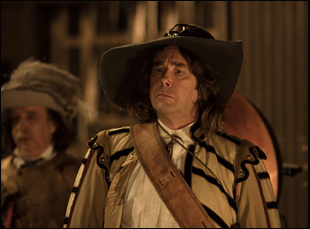
Well, I’m a theater man and what I hate about the image that theater can have is that sometimes people say the theater is a boring place, compared to the movies and TV shows. I’ve been working all my life to make plays that are fast and snappy and interesting and funny, so I didn’t want the style of this movie to be boring. Usually, when theater is filmed, it’s pretty still, but I wanted to be in the middle of the action and give the viewer the experience of being on stage with the actors. To get this, I needed this constant flow and movement and we worked with a steadicam mostly that allowed us to work faster because there were a lot of scenes with a lot of actors and in this case, either you make multiple shots and it takes really long or you try to find a way to make one shot. So the film was always moving and we were trying to navigate between all the actors and find a way to tell the story in a very fluid way.
When you film that way, you can’t cut corners – you have to light and dress the entire set. Did that make it more challenging?
It was a challenge for my DOP, but he’s a very experienced Italian DOP. In his early life, he worked as an operator for Fellini, so it tells you where he comes from and every time I asked him something like this, he said, “Alright,” and in no time, he was ready to shoot. And the crew I had around me really helped and pushed me to be able to be creative and never said, “That’s not possible.” So it was all a matter of being creative and being on time because every director knows that you have to finish your day on schedule, and it was constantly battling between having some new ideas and finding ways to be efficient and fast, so the actors won’t get bored and everybody was alert. Of course, the earlier you finish, the happier the crew is and the happier the crew is, the better results you get from them, so it was all about this.
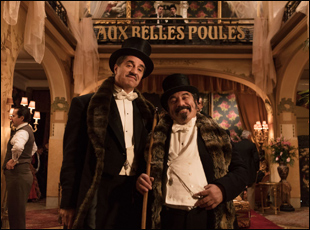
Yeah, it was amazing. I had this in mind for so many years that when I was finally on stage, I was not disappointed at all. I had made some shorts luckily, so I had an idea of what it would be, but the crazy thing is it’s a period movie, so you’re on set and you’re in the period. You’re living things as if you’re there. It was funny with the whole brasserie, having played it onstage so many times because the actor that plays (Monsieur Unorey?), the boss of the cafe who’s going to be an inspiration for Edmond, he’s the only actor that was both onstage and on screen and when he arrived on set and saw his cafe, he had already played it like 300 times, but when he arrived and everything was real, that was insane to live the thing.
It was also quite a challenge. The hardest scene was the balcony scene. It was night in the Czech Republic where we were filming and it was the coldest night of the year – minus 12 degrees celsius. For everyone that was in a period costume, our feet were frozen. But in the end, I think it’s the most beautiful scene in the movie.
I wondered where you got these incredible locations. Was it much of a search?
It all started with the theater. We needed a theater for one month to shoot everything [on the stage] and we couldn’t get it in France, so we searched in Central Europe. We found one in the Czech Republic and when we knew we were going to film there, we knew we had to film the rest of it in the Czech Republic too, so we tried to find some locations that would fit a Parisian 1900 style. We created some of it in CGI too, but we managed to make it work. we had a Paris that was actually Czech. [laughs]
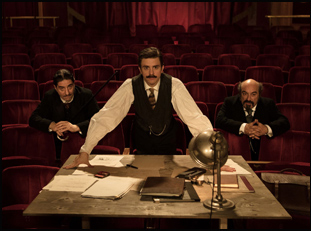
It was pretty controlled. We were very lucky with the weather, and that was my biggest fear because we were on such a tight schedule. But there were some moments where things I tried to put up some kind of a shot and it didn’t work and you think alright, well I have to find another way to make it work. It’s all about time you have on set. I remember this scene where it was just this one shot on Edmond writing, but eventually, we managed to gain some time, so instead of having half an hour, we had two hours to do it, and I figured ”Okay, let’s bring out the crane and let’s do some nice shots.”
Eventually, we did a beautiful top shot coming down and I remember we had a similar thing when I needed shots of the audience reacting [to the play]. It could’ve been simple still shots, but the crew managed to find a way to [create] an improvised crane, building it with just a long tube and put the camera on it. This allowed us to bring the camera over the crowd and have those beautiful camera movements. When I saw this, I was like, “Alright, let’s do some shots” and for an hour, we just did shots of the crowd applauding, reacting, laughing and it was so much better than what I expected. These kind of happy accidents were amazing.
After carrying this around for a decade, what’s it like to let it go?
It’s amazing. It’s really, really fulfilling. The funny thing is I really carried it for 15 years and when I got on set, it didn’t feel like, “Oh, this is too late“ or ”I’m already past it.” I was perfectly at the right place. I felt at the right place. I felt everything I had done until now as an actor, as a theater director and as a writer was going to help me right now on set and help me get the movie I wanted, so once it was done, I really felt something off my shoulders. Then suddenly, it was like what am I going to do next? I did my life plan. So now I feel very free and in the process of searching for whatever I’m going to do next.
“Cyrano, My Love” opens in limited release on October 18th.




